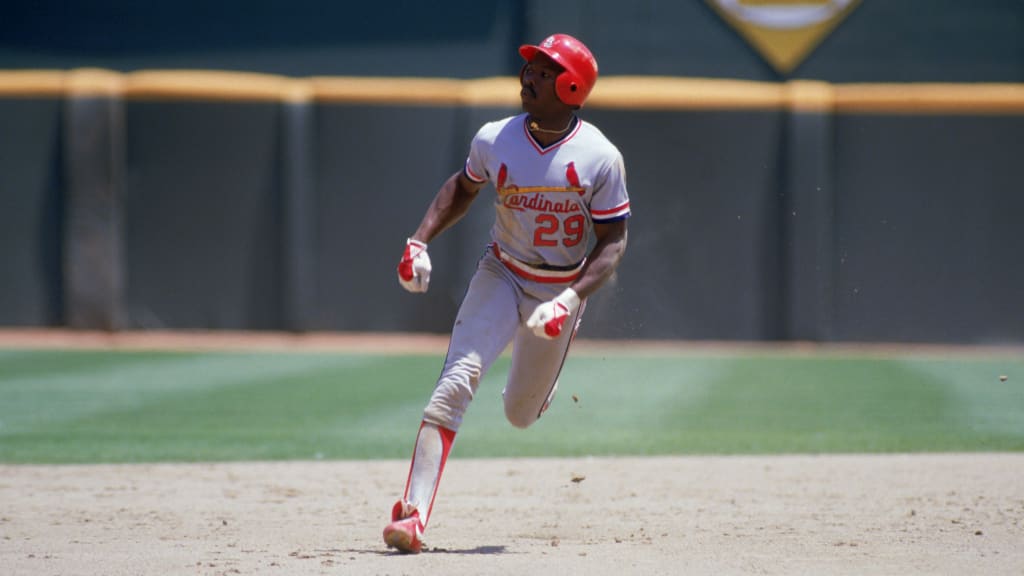
While we’re waiting for baseball to come back, we are making do. So once a week, inspired by the late Deadspin’s “Let’s Remember Some Guys” series, we will take a look at one player in baseball history, why he was great, why he mattered, why we should hang on to him. Send me your suggestions at will.leitch@mlb.com.
Player: Vince Coleman
Career: STL 1985-90, NYM 1991-93, KC 1994-95, SEA 1995, CIN 1996, DET 1997
Accolades: NL Rookie of the Year 1985, All-Star 1988-89
There is an incredible moment in “Heck Of A Year,” the old documentary about the 1985 Cardinals that I watched roughly 700 times at age 10 that I think about all the time. It involves then-Cardinals general manager Dal Maxvill describing a conversation he had with a 23-year-old Minor Leaguer named Vince Coleman, whom he’d just called up from Triple-A Louisville that April because center fielder Willie McGee had a minor hamstring injury.
“I told Vince, when he came up, ‘You’re only gonna be here for about four or five games,'” Maxvill said. “I don’t want you to be disappointed if we send you back down. You understand that?’ He said, ‘Yes, I understand that, but I’m going to be here the whole year.’ And I said, ‘Vince, I want you to have a lot of confidence and everything else, but really, you’re only going to be here for four, five, six days, until Willie’s better, and then you’ll go back to Triple-A and get your work in. You understand?’
"He said, ‘Yes sir, Mr. Maxvill, I understand that. But I’m gonna be here all year.’”
There is something wonderful about that moment, a private one between a baseball executive and a kid who hadn’t played a game in the Majors, neither of whom had any idea how this was all going to work out. Coleman was just a kid from Tallahassee, Fla., a guy who could run like crazy but couldn’t seem to hit, only in St. Louis for a few days until McGee got healthy.
But nope: Coleman wasn’t going anywhere. In his first game, he stole two bases. In his second game, he went 4-for-5 with a double and a triple. In his fourth game, he stole three bases … and was caught stealing twice. He was, instantly, transformed from a cocky rookie to the most exciting player in baseball. Coleman was in the Majors to stay. But 1985 was his peak -- the best it ever was, right from the start.
When you’re as fast as Coleman was, everyone expects you to play football, and he did, but not in the way you’d expect. He was a kicker and a punter at Florida A&M, just like his cousin Greg Coleman, who punted in the NFL for more than a decade. Vince Coleman actually once kicked a game-winning field goal for his Rattlers against heavily favored Miami (Fla.) in 1979, and you should know that it absolutely breaks my heart that I cannot find video of that field goal anywhere on the Internet. One would think at some point a Florida A&M coach would have at least run a reverse for Coleman, but if they did, there’s no video of that either.
When the Cardinals drafted Coleman in the 10th round in 1982 (three rounds after they selected Terry Pendleton), he decided baseball would be his sport. There was one major problem with Coleman as a baseball player, though: He absolutely could not hit.
He hit an empty .250/.349/.269 his first year at Rookie-level ball with no power, with just three extra-base hits (no homers) in 246 plate appearances. At Triple-A in 1984, he hit .257/.323/.334 and struck out more than twice as much as he walked. But Coleman was stealing bases like crazy: 43 in 58 games in '82, 145 in 113 games in '83 and 101 in 152 games in '84. As the Cardinals blog, Viva El Birdos, put it, he was a one-tool player. But what a tool he had!
When Coleman reached the Majors in 1985, he immediately transformed a Cardinals team that had barely finished over .500 the year before and had lost closer Bruce Sutter to Atlanta in the offseason. The Cards were widely picked to finish last in the National League East, and after Neil Allen (the player St. Louis had traded Keith Hernandez for) gave up a walk-off homer to Gary Carter and the hated Mets on Opening Day, the Cards started the season 0-4. They were 2-5 when Coleman was called up, and then they took off.
The Cards went 6-5 the rest of that month, 16-10 in May, 19-8 in June, 17-9 in July, 17-11 in August and a blistering 24-12 over the final month-plus. And Coleman was at the center of it all. He still wasn’t much of a hitter -- batting .267 with a .320 OBP that, as a leadoff hitter, would absolutely not cut it today -- but the chaos he caused every time he reached base was difficult to overstate. The old line was, "Get ‘em on, get ‘em over, get ‘em in,” and that was the entire Cardinals philosophy: Get Coleman on base, let him steal second (and even third), get a ground ball to get him in, have a lead before the other team’s fans have even found their seats.
Coleman ran just about every time he had the opportunity, stealing a stunning 110 bases (still third-most since the Modern Era began in 1900), and it was infectious. McGee stole 56 that year (the most he would ever steal, in the year he won the National League MVP Award), and Andy Van Slyke (34) and Tom Herr (31) had career highs as well, while Ozzie Smith fit in 31. The Cards became a 101-win team seemingly overnight when Coleman arrived, and they were glorious to watch. It might not have been the most efficient baseball, but it was electrifying to experience. There was just constantly something happening.
Coleman's mere presence made you feel as if you were watching something unique, something special, something lasting -- because you were. Here’s the play I’ll always remember the most: Coleman’s first-ever homer, an inside-the-parker in which he crossed the plate standing up, in full sprint. It was if he had broken the game.
Though there was also the double-double steal with Willie McGee. This is what total baseball chaos looks like.
That wasn’t the best Cardinals team of my lifetime -- that would be the MV3 Pujols/Rolen/Edmonds 2004 team that didn’t actually win the World Series -- but it was the most purely enjoyable to watch, which is why the irony of how Coleman’s season remains so truly wild. Before Game 4 of that year's NLCS against the Dodgers, Coleman was stretching on the field when the automatic tarp was deployed on the Busch Stadium turf. It caught his leg and rolled over it, and he ended up missing the rest of the postseason, and that Don Denkinger World Series against the Royals, because of it. The fastest man in baseball was run down by a tarp.
Coleman would steal 439 more bases for the Cardinals over the next five years, including a streak of 50 successful steal attempts in a row in 1989. His first three seasons were mind boggling when it came to stolen bases: 110, 107, 109. He would finally get to play in the World Series, in '87, and he stole six bases. In fact, his 1987 season may have been a better campaign than 1985. Coleman stole 109 bases, batted .289, and had a career-best .363 on-base percentage. He scored 121 runs - the most in his career.
Coleman left St. Louis after the 1990 season and signed as a free agent with the Mets, a team that had won 91 games the year before and looked to be, well, one Vince Coleman away. But Coleman had all sorts of off-field issues. He once hurt Dwight Gooden’s arm with a golf club, fought with coaches and managers and ultimately was arrested and charged with a felony for throwing firecrackers at a group of fans, injuring a 1-year-old girl.
The Mets never played him again after that, and he was traded to Kansas City, then signed with Seattle, then Cincinnati, then Detroit, then one last-ditch effort to stick with the Cardinals in 1998, who never promoted him beyond Triple-A. (It’s wild to imagine Coleman playing on that Cardinals team while Mark McGwire went for the home run record.) You can even see Coleman celebrating with Ken Griffey Jr. and Alex Rodriguez when Griffey scored the game-winning run in the '95 ALDS:
But those are all different versions of Coleman. A later Coleman, controversial Coleman, divisive Coleman, disappointment Coleman. The best way to remember Vince Coleman is to look at that 1985 season, when he stole bases like no rookie had before and changed the way the whole darned game was played. Coleman, 23 years old and ready to take over the world, showed up and said he absolutely was not leaving. He didn’t. And there hasn’t been anyone like him since.
Send me the player you’d love to have me write about at will.leitch@mlb.com.
